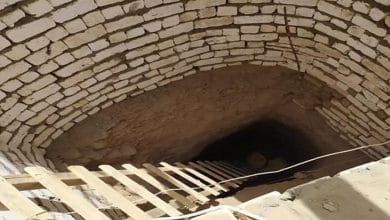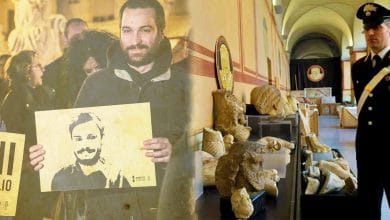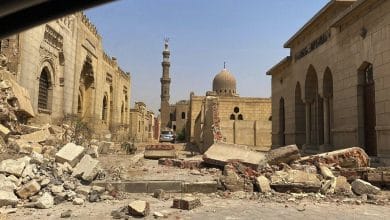
On April 3, 2021, the world witnessed a unique historical event, the largest Egyptian royal parade, including 22 kings and queens, on a royal journey that took about an hour; where the kings and queens were transferred from the Egyptian Museum in Tahrir to the National Museum of Civilization in Fustat.
Royal mummies
The royal mummies date back to the period from the sixteenth century BC, the era of King Seqenenre Taa, until the twelfth century BC, the era of King Ramses IX, one of the kings of the twentieth dynasty. Among these mummies, there are 18 mummies for kings, and 4 mummies for queens.
It is noteworthy that the royal mummies were found grouped with other mummies in several cachettes and tombs, most notably, the Deir el-Bahri cachette in Luxor in 1881, and the King Amenhotep II Tomb cachette in the Valley of the Kings, Luxor also in 1898.
Ten out of the 22 mummies were found in the Deir el-Bahari cachette, known as ‘Tomb 320’, including 9 mummies for kings and one for a queen. Nine mummies were found in the cachette of King Amenhotep II tomb, known as ‘Tomb 35’ at the Valley of the Kings. The mummies of the other three queens were found separately in other tombs.
Deir el-Bahari cachette
The ancient Egyptian priests prepared the cachette of Deir al-Bahari for transference of the mummies of kings and princes, with the aim of protecting them from theft, where they stacked mummies on top of each other, as 50 mummies were found in the cachette when they were officially discovered in 1881.
The site of the Deir al-Bahari cachette is a chasm connected to a vertical wellhead that ends with two stones linked by a corridor, about 40 meters long, where the whole tomb is about 70 meters long. The first ten meters of the tomb with the main corridor are L-shaped. This chasm was covered in 1881, but it was then reopened once again in 1882. Both French Egyptologist Gaston Maspero and German Egyptologist Heinrich Brugsch used to enter the tomb to study it, as Maspero transferred the inscriptions on its walls and interpreted them.
The cachette of the tomb of Amenhotep II
The cachette of the tomb of Amenhotep II, or ‘Tomb 35’ in the Valley of the Kings, Luxor, was the final resting place of King Amenhotep II, the sixth king of the 18th. Dynasty. The tomb has many architectural features that had not been previously known in tombs of that era. It was used during the reign of the 21st. Dynasty by priests as a hideout to bury the mummies of a number of kings for fear of theft, including King Thutmose IV, Amenhotep III, Merenptah, Seti II, Siptah, Ramses IV, Ramses V, Ramses VI, and Queen Tiye , in addition to another mummy that is likely to be of King Setnakhte. Later, the mummies of both the tomb owner, King Amenhotep II and his son, Webensenu, as well as the mummy of Queen Merytre-Hatshepsut, mother of King Amenhotep II, were found in the cachette of the tomb of Amenhotep II.
Kings of the Golden Parade
The parade carried the mummies of 22 kings and queens, including the mummies of 18 kings, namely:
1- King Seqenenre Taa:
King Seqenenre Taa (1560-1555 BC), the last 17th Dynasty King and one of the most important kings, was the ruler of Thebes (currently Luxor). Seqenenre Taa was the one that began the liberation war against the Hyksos and was killed in one of the battles against them, where he died after receiving a painful blow in his head through an Asian ax that was among the Hyksos weapons, according to an ancient Egyptian papyrus called “Sallier Papyrus I” that portrayed part of the events. His mummy was found inside a massive anthropoid coffin carved in cedar at El-Deir El-Bahari (TT320), west of Luxor in 1881.
2- King Amenhotep I:
King Amenhotep I (1525-1504 BC) is the son of King Ahmose I and Queen Ahmose-Nefertari. He is the second pharaoh of the 18th Dynasty. Amenhotep I may have been a child when he became king and ruled with the assistance of his mother, Queen Ahmose-Nefertari. Amenhotep I led a number of campaigns, and had a long fighting record in the south. He also began or completed a number of projects, and it is believed that during his reign, the workers’ village in Deir el-Medina area, Luxor, was established, where he was canonized there later. His mummy was discovered in an anthropoid coffin made of cedar and adorned with floral garlands, in the Deir El-Bahari cachette (TT 320), west of Luxor in 1881.
3- King Thutmose I:
King Thutmose I (1504-1492 BC) is the third king of the 18th Dynasty, who was distinguished by his military achievements, and therefore remembered as a warrior pharaoh that accomplished substantial campaigns and the Egyptian Empire expanded to the south and the north up to the Euphrates River. He was the first king of the 18th Dynasty to use the Valley of the Kings in Luxor as tombs for the royal family. His mummy was discovered in 1881 inside a coffin set, at the El-Deir El-Bahari. The mummy was found in an excellent state of preservation.
4- King Thutmose II:
King Thutmose II (1492-1479 BC) is the son of King Thutmose I. He tried to complete his father’s military achievements. He got married to Queen Hatshepsut, but his rule did not last for long as he died at the age of 30. His mummy was discovered (TT 320) west of Luxor also in 1881.
5- King Thutmose III:
King Thutmose III (1479-1425 BC) is one of the great warrior pharaohs of the New Kingdom of Egypt, and son of King Thutmose II. He launched a series of military campaigns in defense of Egypt, especially in the eastern side, where his armies reached the Levant, Euphrates and present Anatolia. His unique victory at the famous Battle of Megiddo is considered a model of military strategy. The Mummy of the king was discovered in the El- Deir El-Bahari cachette (TT 320), west of Luxor in 1881.
6- King Amenhotep II
King Amenhotep II (1427-1400 BC), the seventh king of the 18th Dynasty, is known as the athletic King, as inscriptions and pictures about him reflect his interest in sports. He maintained the borders of the empire solidified by his father and fought campaigns securing wealth and power for Egypt, especially in defending the eastern borders towards Syria, or in securing the southern borders in Nubia. Amenhotep II’s mummy was discovered inside the quartzite sarcophagus in 1898 in the tomb of Amenhotep II (KV 35) at the Valley of the Kings.
7- King Thutmose IV:
King Thutmose IV (1400-1390 BC), son of King Amenhotep II, is associated with the well-known “Dream Stela” that he erected between the paws of the Great Sphinx at Giza, where this painting documents Thutmose IV’s cleaning and removal of the sand off the body of the Sphinx as political propaganda to enable him to take over Egypt’s throne. His reign was characterized by peace with the countries and kingdoms of the ancient Near East, such as Mitanni. The mummy of the king was discovered in 1898 in the tomb of Amenhotep II (KV 35).
8- King Amenhotep III:
King Amenhotep III (1390-1352 BC), one of the greatest kings of ancient Egypt, is the son of King Thutmose IV, New Kingdom, Dynasty 18, by his wife Mutemwiya. His reign is considered the utmost prosperity of the modern state, which made him worthy of being called “the magnificent ” in Western studies. He is also known for correspondence with the kings and rulers of the ancient Near East countries, such as Babylon and Mitanni, where these letters were found in the Amarna region of Minya. The King’s mummy was discovered in 1898 in the tomb of Amenhotep II (KV 35).
9- King Seti I:
King Seti I (1294-1279 BC), the second king of the 19th Dynasty, is known for many great constructions, such as contributing to the construction of the Great Hypostyle Hall at Karnak Temple, as well as his famous funerary temple in Abydos, Sohag. King Seti I has a rich fighting record, as he pursued all Asian Bedouins and responded to the attacks of the Hittites. In addition, he had a mining activity in the Eastern Desert and Nubia. His mummy was discovered in 1898 in the tomb of Amenhotep II (KV 35) at Valley of the Kings in Luxor.
10- King Ramses II:
King Ramses II (1279-1213 BC), the third king of the 19th Dynasty, is the most famous and greatest king of ancient Egypt. He has done many great deeds, including construction of the Ramesseum funerary temple in Luxor, and a large part of the Great Hypostyle Hall at Karnak Temple, as well as many Nubian temples, such as the Great Abu Simbel Temple and the small Abu Simbel temple, which he built for his wife, Queen Nefertari. Ramses II has had a remarkable war activity and he is remembered as a great warrior at the Battle of Kadesh, in which he fought against the Hittites. He signed the first known peace treaty in history with the Hittites. The Mummy of the king was discovered in the El-Deir el-Bahari cachette (TT 320).
11- King Merenptah:
King Merenptah (1213-1200 BC), the fourth king of the 19th family, is the son of King Ramses II. He launched several campaigns against the Libyans. He is also associated with the widely known “Israel Stele”, which makes reference to the utter destruction of the Israelite tribes in one of his campaigns: “Israel has been wiped out…its seed is no more,” as they posed as a threat to the trade routes at the time. His mummy was discovered in 1898 in the tomb of Amenhotep II (KV 35).
12- King Seti II:
King Seti II (1200-1194 BC), the fifth king of the 19th Dynasty, is likely the legitimate heir of King Merenptah. He is known for his mining activity in Sinai, and undertaking some minor constructions at Karnak. His mummy was discovered in 1898 in the tomb of Amenhotep II (KV 35) at the Valley of the Kings.
13- King Siptah:
King Siptah (1194-1188 BC), the penultimate king in the 19th Dynasty, assumed the throne after the death of his father, King Seti II, probably in light of great turmoil and difficulties during struggle for the throne. His mummy was discovered in 1898 in the tomb of Amenhotep II (KV 35) in Valley of the Kings, Luxor.
14- King Ramses III:
King Ramses III (1184-1153 BC), one of the most important and famous kings of the twentieth Dynasty, addressed the danger of Sea Peoples. The first strike in history was also recorded during King Ramses III’s reign. He was exposed to a famous assassination plot orchestrated by his wife, that was known as the “harem conspiracy”. The Mummy of King Ramses III was discovered in (TT 320).
15- King Ramses IV:
King Ramses IV (1153-1147 BC), the third king of the 20th dynasty, had a mining activity in the eastern desert, and his tomb was located in the Valley of the Kings. One of the most important documents to survive from this pharaoh’s rule is the Turin papyrus, the earliest known geologic map, currently kept in the Turin Museum, Italy. His mummy was discovered in 1898 in the tomb of Amenhotep II (KV 35).
16- King Ramses V:
King Ramses V (1147-1143 BC), the fourth king of the twentieth Dynasty, had a mining activity in Sinai. His reign is distinguished by two of the most famous and most important papyri, namely: the Wilbour Papyrus, a major land survey and tax assessment document in Ancient Egypt; and the Turin 1887 Papyrus that tells about financial corruption in the state’s administrative apparatus, particularly a financial scandal involving the priests of Elephantine. Ramesses V died early presumably with smallpox. His mummy was discovered in 1898 in the tomb of Amenhotep II (KV 35).
17- King Ramses VI:
King Ramses VI (1143-1136 BC) is the fifth king of the 20th Dynasty and son of King Ramses III. During his reign, the Egyptian influence continued in parts of the Syrian coast and also in Nubia. His mummy was discovered in 1898 in the tomb of Amenhotep II (KV 35).
18- King Ramses IX:
King Ramses IX (1126-1108 BC) is the eighth king of the 20th family and grandson of Ramses III. The conditions started to become more turbulent and difficult during his reign, as the power of the priests of Amun as well as the aspirations of Libyan mercenaries escalated, where they were able to access power later. His mummy was moved several times before it was hidden in the Deir El-Bahari, where it was discovered in 1881.
The parade also carried the mummies of 4 queens, namely:
1- Queen Ahmose-Nefertari:
Queen Ahmose-Nefertari, one of the greatest queens of ancient Egypt with an immortal effect, is the royal wife of King Ahmose I and the royal mother of King Amenhotep I. She is the first queen to acquire the title of the divine wife of Amun, which was demonstrated through a number of privileges that were bestowed upon her, according to a well-known stela. She remained immortalized as she and her son Amenhotep I were venerated as a divinized couple by the Egyptians, especially in the Necropolis of Deir El-Medina.
2- Queen Hatshepsut:
Queen Hatshepsut (1473-1458 BC), the Daughter of King Thutmose I, the wife of King Thutmose II, the regent on behalf of her stepson Thutmose III, after the death of her husband, and then the Queen of Egypt. The most famous of her construction activity is the temple of Deir al-Bahari, Luxor, a unique temple carved into the rock. One of her most famous employees was Eng. Senenmut, who was entrusted with raising her daughters. She is also known for her commercial activity, manifested in her famous trade expedition to the land of Punt. Her mummy was discovered in 1903 in tomb number KV 60 at the Valley of the Kings.
3- Queen Meritamun:
Queen Meritamun is the daughter of King Ahmose I and Queen Ahmose-Nefertari. She acquired several titles as King’s Daughter, King’s Sister, Great Royal Wife; and was married to King Amenhotep I. Her mummy was discovered in 1930 in tomb number (TT 358) also in the cachette of El-Deir El-Bahari, west of Luxor.
4- Queen Tiye:
Queen Tiye, the eldest royal wife of King Amenhotep III, is the daughter of “Yuya”, a senior official of the royal court during the reign of King Amenhotep III. and “Tuya”, singer of the goddess Hathor. Her mummy was discovered in 1898 in a side room of Tomb of King Amenhotep II (KV 35) in the Valley of the Kings.
Conclusion
The plan to transfer the royal mummies from the Egyptian Museum in Tahrir to the National Museum of Egyptian Civilization (NMEC) in Fustat, Cairo, is part of a large project that began in 2002 in attempt to reorganize Egyptian museums and develop their screening scenarios. The project was started by Former Minister of Culture Farouk Hosni, who laid the foundation stone for the Grand Egyptian Museum, expected to open later as distinguished by inclusion of the Tutankhamun Hall. The foundation stone of the NMEC was also laid in 2002, with its main feature of housing the Royal Mummies Hall.
Despite the fact that the contents of the Tutankhamun Hall transferred to the Grand Egyptian Museum, and the contents of the Royal Mummies Hall transferred to the National Museum of Egyptian Civilization, have all been taken from the Egyptian Museum in Tahrir, however, the latter, with its remaining contents exceeding one hundred thousand pieces, will remain attractive to domestic and external tourism, in addition to the fact that its premises which was built in 1902, has become a monument that must be preserved.
To Read Text in PDF Format Click here.



